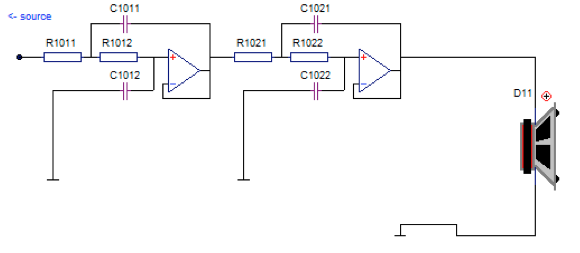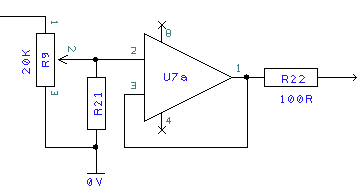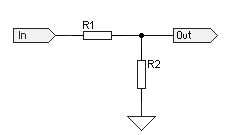Looking forward to the time when I eventually have my nice 3-way Ergo IIIR speakers, I'm preparing a new design of active XO (the old one was a bit crap). Thing is, I have some questions that I don't know how to answer and hoped some of you chaps might be able to help.
I've been chatting to James (the speakers' designer) who has done careful in-situ measurements of the speaker drivers and used that data to run some LSPCad simulations in order to design a customized set of resistor/capacitor filter values for a Linkwitz-Riley 4th order active XO. The XO is tailored to the E-IIIR and provides almost perfect phase alignment at the crossover regions and a practically ruler-flat summed frequency response over the audio spectrum. Which is nice
I'm designing the PCB for the XO and want to optimize it as much as possible; this will not be a generic active XO PCB - it's for the E-IIIR only. As such there are some implementation details I could use some help with.
Filter cascading
Rod Elliott's very popular 3-way LR4 XO looks like this:

You can see that the low pass (bass) filter takes its signal input from the output of the low-pass section of the bandpass filter. This is because (in Rod's words) if you do not connect them exactly as shown:
However, the diagrams generated by LSPCad clearly show that the input to each filter (high, mid, bass) are to be taken from the music "source". For example, here's LSPCad's bandpass filter:

The bass filter also takes its input direct from the source in the LSPCad version:

The bandpass diagram differs in 1 very important way from Rod's diagram: It has the high pass section before the low pass section. This is important because in Rod's configuration the input to the bass filter is taken from the the output of the first stage of the bandpass, which in his case is a low-pass filter.
If I was to take the same approach here I'd end up feeding the bass filters from a high pass filter, which would actually remove the lower frequencies, which would completely screw up the bass.
So my though here is this: ignore Rod's diagram and trust that LSPCad knows what its talking about and has taken into account phase shifts and whatnot in its calculations. In other words: Rods schematic is particular to his XO, and LSPCad's schematic is particular to the EIIIR XO.
Any thoughts? James and I have had inconclusive chats about this!
Output Buffers / speaker sensitivity compensation
The drive units in the E-IIIR have the following sensitivity:
Hiqphon OW-1 tweeter: 87dB
Scan-Speak 25W8565-01 woofer: 88dB
Seas M15CH001 midrange: 90dB
As you can see, if I simply connected the active XO outputs to 3 power amps each driver would have a vastly different output level! To correct this I could borrow Rod's idea of using a voltage divider + output buffer opamp at the output of each filter to reduce the levels of the bass and midrange outputs so that they match the tweeter sensitivity. Something like this, where R21 is 10k:

I'd use one buffer for mid (dropping the level by 3dB) and one for the bass (dropping the level by 1dB). The values would be tweaked for preference using the multi-turn trimmers, which would then be replaced with fixed value resistors once I'm happy. The tweeters don't need to have their levels dropped because they have the lowest sensitivity and they're the baseline against which the mid and bass are being adjusted.
Because of this (no need to drop tweeter levels) I'd like to avoid using an output buffer for the treble output - there seems to be no point in having an extra opamp in the signal path - but I have a concern: does a unity-gain unflitered opamp add phase shift? If so, it would seem that omitting an output buffer for treble while using output buffers for mid and bass would lead to unwanted phase shifts in the mid and bass outputs.
Does anyone know the truth of the matter? Should I add an extra output buffer for treble to account for phase shift in the mid and bass?
Alternative level adjustment
Perhaps output buffers are overkill. Would it make sense to instead use voltage dividers at the inputs to the mid and bass filters? In other words: drop the input signal level before the filter sections so that the outputs from the filters are perfectly matched for the drive unit sensitivities.
This seems like a more simple/minimalist solution but I don't know enough to understand any negative side effects of this approach. Help?!?
Sorry for the very long post!
I've been chatting to James (the speakers' designer) who has done careful in-situ measurements of the speaker drivers and used that data to run some LSPCad simulations in order to design a customized set of resistor/capacitor filter values for a Linkwitz-Riley 4th order active XO. The XO is tailored to the E-IIIR and provides almost perfect phase alignment at the crossover regions and a practically ruler-flat summed frequency response over the audio spectrum. Which is nice
I'm designing the PCB for the XO and want to optimize it as much as possible; this will not be a generic active XO PCB - it's for the E-IIIR only. As such there are some implementation details I could use some help with.
Filter cascading
Rod Elliott's very popular 3-way LR4 XO looks like this:

You can see that the low pass (bass) filter takes its signal input from the output of the low-pass section of the bandpass filter. This is because (in Rod's words) if you do not connect them exactly as shown:
Rod Elliott said:phase shifts through the system will cause the summed output to be different from what you expect. The sections are connected together to give the best outcome - changes will cause unexpected variations, none of which is likely to be good
However, the diagrams generated by LSPCad clearly show that the input to each filter (high, mid, bass) are to be taken from the music "source". For example, here's LSPCad's bandpass filter:

The bass filter also takes its input direct from the source in the LSPCad version:

The bandpass diagram differs in 1 very important way from Rod's diagram: It has the high pass section before the low pass section. This is important because in Rod's configuration the input to the bass filter is taken from the the output of the first stage of the bandpass, which in his case is a low-pass filter.
If I was to take the same approach here I'd end up feeding the bass filters from a high pass filter, which would actually remove the lower frequencies, which would completely screw up the bass.
So my though here is this: ignore Rod's diagram and trust that LSPCad knows what its talking about and has taken into account phase shifts and whatnot in its calculations. In other words: Rods schematic is particular to his XO, and LSPCad's schematic is particular to the EIIIR XO.
Any thoughts? James and I have had inconclusive chats about this!
Output Buffers / speaker sensitivity compensation
The drive units in the E-IIIR have the following sensitivity:
Hiqphon OW-1 tweeter: 87dB
Scan-Speak 25W8565-01 woofer: 88dB
Seas M15CH001 midrange: 90dB
As you can see, if I simply connected the active XO outputs to 3 power amps each driver would have a vastly different output level! To correct this I could borrow Rod's idea of using a voltage divider + output buffer opamp at the output of each filter to reduce the levels of the bass and midrange outputs so that they match the tweeter sensitivity. Something like this, where R21 is 10k:

I'd use one buffer for mid (dropping the level by 3dB) and one for the bass (dropping the level by 1dB). The values would be tweaked for preference using the multi-turn trimmers, which would then be replaced with fixed value resistors once I'm happy. The tweeters don't need to have their levels dropped because they have the lowest sensitivity and they're the baseline against which the mid and bass are being adjusted.
Because of this (no need to drop tweeter levels) I'd like to avoid using an output buffer for the treble output - there seems to be no point in having an extra opamp in the signal path - but I have a concern: does a unity-gain unflitered opamp add phase shift? If so, it would seem that omitting an output buffer for treble while using output buffers for mid and bass would lead to unwanted phase shifts in the mid and bass outputs.
Does anyone know the truth of the matter? Should I add an extra output buffer for treble to account for phase shift in the mid and bass?
Alternative level adjustment
Perhaps output buffers are overkill. Would it make sense to instead use voltage dividers at the inputs to the mid and bass filters? In other words: drop the input signal level before the filter sections so that the outputs from the filters are perfectly matched for the drive unit sensitivities.
This seems like a more simple/minimalist solution but I don't know enough to understand any negative side effects of this approach. Help?!?
Sorry for the very long post!


